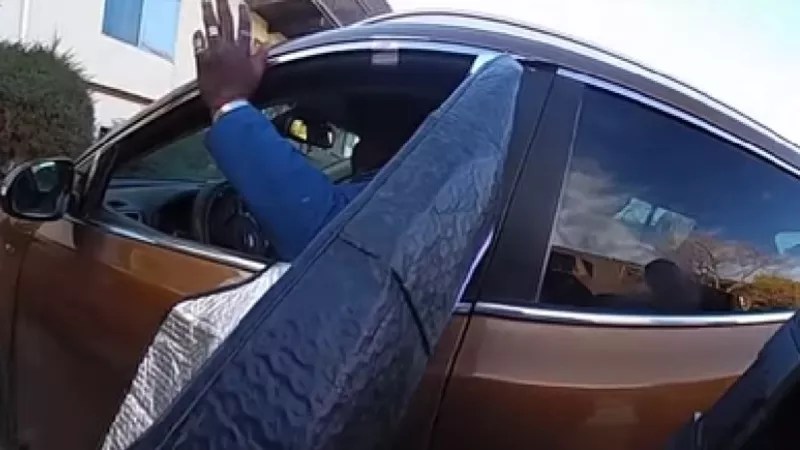
Arapahoe County Sheriff’s Office via YouTube

Audio By Carbonatix
So far this year in Colorado, thirty people have been killed during officer-involved shootings – which now total 52 after an overnight incident at a Lone Tree RTD station in which two alleged car thieves died. Also on this roster is Jamarian McGhee, a thirty-year-old man fatally shot in March by Deputy Daniel Willmont of the Arapahoe County Sheriff’s Office when he tried to flee in a stolen car from law enforcement officers who’d awakened him.
This incident echoes the circumstances behind two more officer-involved-shooting deaths in Colorado that have made recent headlines – and Chuck Wexler, executive director of the Police Executive Research Forum (PERF), a think tank based in Washington, D.C., is frustrated that such homicides keep happening. After all, officers are prohibited from shooting into moving vehicles “by most major police departments in this country,” he said to Westword earlier this month. “But unfortunately, there are still departments that are not aware of this as a best practice.”
The Arapahoe County Sheriff’s Office use-of-force manual doesn’t prohibit shooting into moving vehicles, stating only that “Members should not intentionally or recklessly create the need to discharge a firearm at a vehicle by placing themselves directly in the path of a suspect vehicle if it can reasonably be avoided, and members should immediately move out of the path of a vehicle whenever reasonably possible.”
Body-worn-camera footage released by the ACSO on October 20 shows that Willmont and fellow deputies Kenneth Foley and Joshua Bandstra complied with this advisory. As a result, they were never in danger of being struck by the sport-utility vehicle driven by McGhee, but Willmont chose to shoot at him anyway, even though the automobile was essentially boxed in and had nowhere to go – and while a firearm was later found inside the car, McGhee never brandished it at the deputies.
The ACSO account of the shooting begins at around 7:40 a.m. on March 3, when Willmont received “a citizen request to investigate a suspicious vehicle.” Upon confirming that the car, a brown KIA Sportage SUV, had been reported stolen, he called for assistance. Once Foley and Bandstra arrived, the three approached McGhee, who was asleep behind the wheel of the Kia, and asked him to show both of his hands. Instead, McGhee displayed only one. A few minutes later, McGhee put the vehicle into reverse, tapping a patrol car in the process. At that point, Foley fired a taser through the driver’s side window while Willmont used what’s described as “his agency-issued rifle” to shoot through the Kia’s rear window as McGhee shifted into drive. The car slowly rolled to a stop seconds later, and the deputies soon discovered that McGhee had been hit in the back. Despite efforts to revive him, he was pronounced dead at the scene
Here’s the video, which includes body-worn-camera recordings from all three deputies. McGhee reverses the car at around the fifteen-minute point.
The circumstances of the shooting are very similar to those at the center of two fatal interactions between Colorado law enforcement officers and unconscious car thieves that led to lawsuits.
In late August, a confidential settlement was reached regarding the Halloween 2020 killing of John Pacheaco, who’d been passed out in a stolen truck on Colorado Boulevard seconds before Glendale Police Department officers Chandler Phillips and Neil McCormick unloaded nineteen shots into the vehicle when he attempted to drive it away. And on September 28, Westword reported that the Colorado State Patrol, represented by the Colorado Attorney General’s Office, had agreed to settle a lawsuit over Trooper Gregorio Retana’s killing of nineteen-year-old Ryan Millsap in Jefferson County in 2018; Millsap and a companion were also asleep in a stolen car before he was stirred and attempted to escape. At the time, Sean Simeson of Englewood-based Baumgartner Law, one of the attorneys for Millsap’s mother, said that the settlement was “pending approval by a state committee, which is merely a formality.” Nonetheless, both the CSP and the AG’s office rejected Westword‘s request for information under the Colorado Open Records Act, citing a statute enforcing confidentiality in arbitration and mediation.
PERF’s Wexler sees such tragedies as eminently preventable, since policies directing officers not to shoot at moving vehicles unless a weapon other than the car itself has been produced date back fifty years; the police department in New York City instituted the procedure in 1972 following a officer-shooting death of a ten-year-old. Since then, law enforcement agencies from coast to coast have followed the NYPD’s lead, including the Los Angeles Police Department and the Denver Police Department, which installed the rule amid uproar over the 2015 death of seventeen-year-old Jessica Hernandez; the city paid just under $1 million to settle that case. But the procedure hasn’t become universal, for reasons Wexler attributes to scale and habit.
“With over 16,000 police departments in the United States, many of them with under 25 officers and no national standards, old practices are hard to change,” he told Westword. “And in some departments, the issue is as much about culture as policy. If someone doesn’t stop, people think it gives them the right to use whatever force is necessary. But today, we need to talk in different terms, including about the sanctity of human life, and the fact that everyone deserves to go home at night – the police officer, but the car thief, too.”
After noting that stealing a car is considered a relatively low-level crime that frequently results in minor punishment, Wexler asked: “How can you justify using deadly force on someone stealing a car when practically no one even goes to jail for it anymore? Why would you think you’d need to shoot them over a car? Do you care about the car, or do you care about the lives? If that person gets away, you can get them another day.”
The fatal shooting of Jamarian McGhee remains under investigation by the 18th Judicial District Critical Response Team.